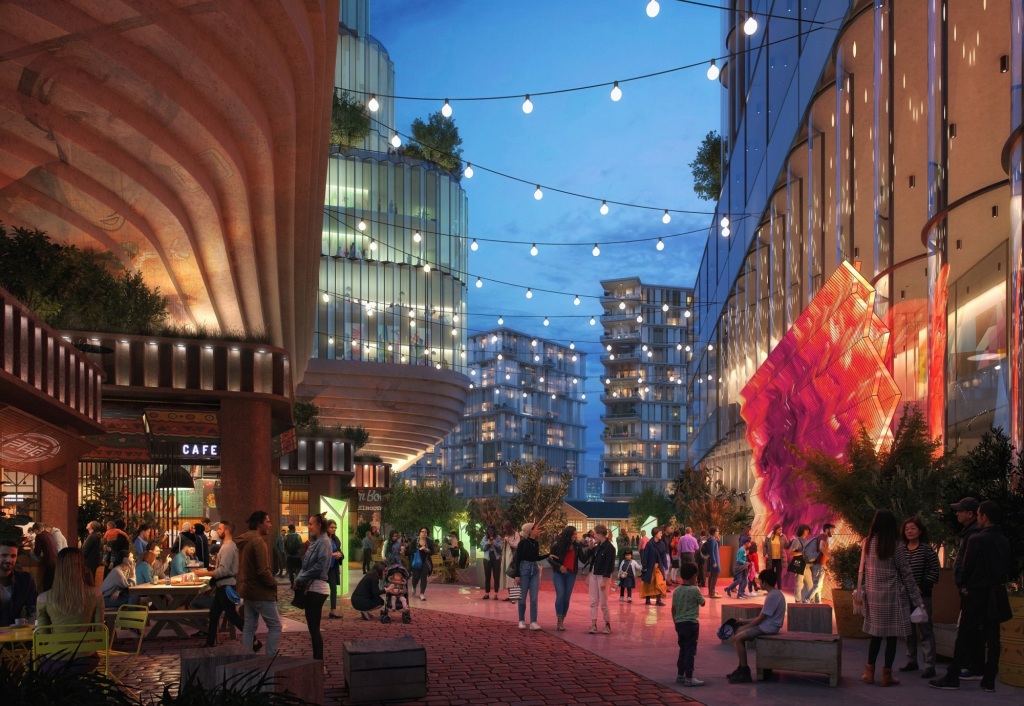SAN JOSE — Google is edging closer to the launch of its development of a new downtown San Jose neighborhood by moving to complete land transfers for parcels dating back to the mid-19th century.
The properties in question are near an old bakery and telephone company building on the western edges of downtown, according to documents on file with the Santa Clara County Superior Court.
Google and San Jose are working together through litigation they filed to ensure that ownership of the remnants of some small parcels within the development footprint of Google’s future transit village in the area are all transferred by court order to the search giant and the city.
“We’re working with the city of San Jose on a land transfer process,” a Google spokesperson said.
Google’s new transit-oriented neighborhood, known as Downtown West, is expected to create offices, homes, shops, restaurants, hotels, cultural loops, entertainment centers and open spaces in an area long occupied by low-slung industrial buildings. The new village also is set to bring San Jose an array of community benefits, although some opponents worry the tech giant’s massive project will contribute to gentrification.
“The Downtown West project will be creating a first-of-its-kind $154 million community stabilization and opportunity pathways fund that is 100% focused on social equity,” Google said in the court papers.
A court ruling that definitively assures Google and the city have clear and unquestioned ownership of the small parcel remnants is a crucial step ahead of the start of the project. The properties are near the corner of South Montgomery Street and Park Avenue.
The legal process is formally known as “quieting” the title for the parcels that are involved.
The litigation named at least 37 individuals who are believed to be descendants of three men who obtained some of the original land grants in San Jose, consisting of about 300 acres in and next to the city’s downtown district. The properties were originally bought in or circa 1865, the court papers show.
The original buyers, the court papers show, were:
— Frederick H. Billings. Billings was a lawyer and financier who was active on land claims during the early years of California’s statehood. Billings also was president of the Northern Pacific Railway.
— Archibald Peachy. Peachy, a lawyer and state legislator, co-founded with Billings the law firm Halleck, Peachy & Billings.
— Henry M. Naglee. Naglee was a Civil War general in the Union Army who was also a banker and a vintner who bought land not only in the downtown area but also in areas east of the current downtown.
The lawsuit has been lodged against individuals who are or may be descendants of these three men and who might at some point attempt to impede the project or seek damages as a result of the development.
“Google is informed and believes and on that basis alleges that the defendants claim or may claim an interest adverse to Google’s title in the subject properties,” the tech titan stated in the court papers. The city of San Jose makes a similar allegation in the filing.
The move by Google is a strong sign the search giant is fully committed to a swift start for infrastructure improvements that would need to be completed ahead of the start of construction of actual buildings in the Downtown West project, said Bob Staedler, principal executive with Silicon Valley Synergy, a land-use consultancy.
“This legal action is the brightest light possible that shows Google is pushing hard to get the infrastructure upgrades started this year,” Staedler said.
The tech titan is pursuing the legal procedure out of an abundance of caution, in Staedler’s view.
“This is Google measuring three times and cutting once,” Staedler said. “They are doing this the right way.”
Google and San Jose aim to ensure that some of the streets that will become part of the project will be areas accessible to the public, the tech company said.
“It is our shared goal to optimize the public benefits of this project, including reconfiguring streets into open space and bike and pedestrian trails to give the community a more walkable, transit-oriented downtown,” the Google spokesperson said.










